The Enigma of Bellholes
School of Chemistry, F11, The University of Sydney, NSW 2006
Email: J.James@chem.usyd.edu.au
Abstract
Many caves in the Gunung Mulu National Park, Sarawak, Malaysia have outstanding displays of bellholes. Prolific bellhole arrays are also found in the caves of the Neotropics and Madagascar. The riddle lies in how these surprisingly symmetrical speleogens form. In Lagang Cave, beneath an exceptional display of bellholes, Australasian Cave and Karst Management Association members held a brain storming session focusing on their formation that resulted in a wide range of theories. However, in the recent speleological literature, only two theories have been put forward which have been substantiated by research: that bellholes are formed by harems of bats, or are formed by condensation corrosion. These two hypotheses will be combined into one, that bellholes are initiated and developed by condensation corrosion and modified by bats. Bellholes are believed to be a fast forming speleogen in tropical caves. In caves outside tropics where they are not common, they may be slow forming or relict.
Introduction
Bellholes were first reported in Jamaica in 1953 by V.A. Zans (White, 1962) and in Sarawak in 1966 (Wilford, 1966). In 1971, Miller commenced documenting their occurrences in the Neotropics. Recently they have been reported from Madagascar (Grunwald and Wolozan, 2006 and Middleton pers. com., 2010). Bellholes have been extensively studied in the Neotropics (Birmingham et al., 2011). Extensive arrays of bellholes are found in caves of the Gunung Mulu National Park, Sarawak, Malaysia. To date, there have been a number of hypotheses as to the formation of these remarkable speleogens. The terminology of Jennings (1971) will be used, that is bellhole, as per the geomorphic pothole. The split “bell hole” is also found throughout the literature on this topic.
Discussion
Bellholes (Figure 1) are symmetrical, circular, vertical cavities found in the ceilings and overhangs of caves interiors and are most striking where they have pock marked extensive areas of flat cave ceilings (Figure 2). Bellholes have circular diameters of 50-500 mm, with the height of the cavity extending from a few millimetres to two metres. They are usually found in solid rock without obvious control by dip, bedding, joints, lithology or morphology. The angle from horizontal of the rock surface is unimportant and examples have been recorded in speleothems. When their diameter and cavity height are closely related, the holes resemble the interior surface of a bell, especially as the entrance to the bellhole shaft is slightly flared. The bellholes with extended cavity heights resemble the interior of a pipe capped with rock or calcite. To be a bellhole these features must be capped and in solid rock or speleothem calcite.

Figure 1. The holes resemble the interior surface of a bell. The bellholes in the figure are up to 150 mm in diameter and 300 mm in depth. Photo Julia James.

Figure 2. Bellholes in Lang’s Cave, Gunung Mulu National Park, Sarawak. The bellholes are found on the flat roof of the entrance passage within the twilight zone. Photo Julia James.
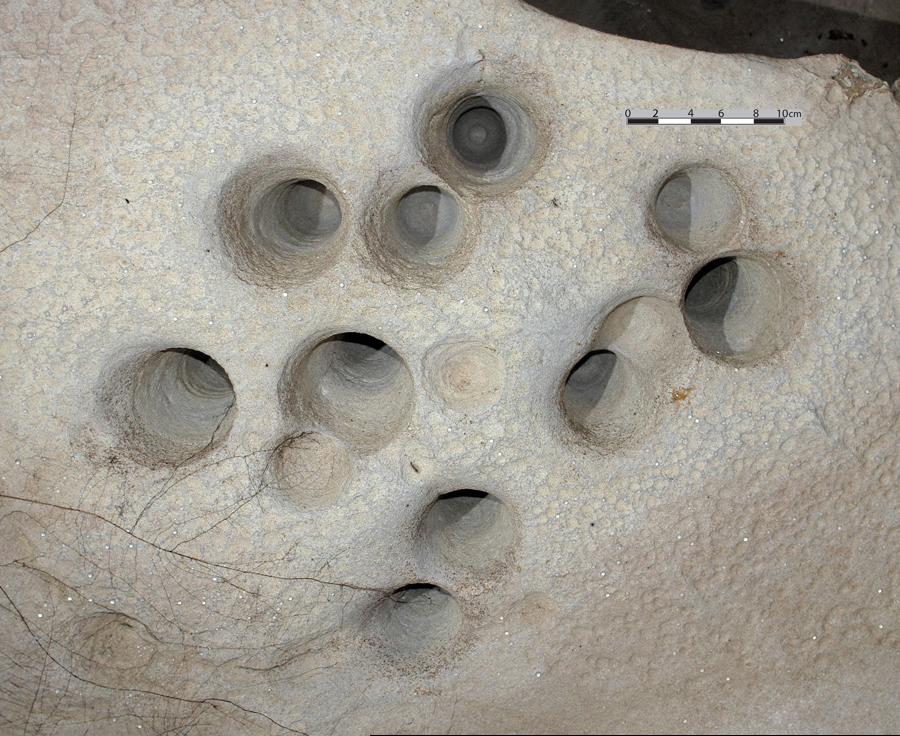
Figure 3. A display of bellholes in Fruit Bat Cave, Gunung Mulu National Park, Sarawak. Photo John Brush.
Speleologists attending the Australasian Cave and Karst Management Association AGM, 2010 at Gunung Mulu National Park, Sarawak while waiting at the gated entrance to Lagang Cave had a brain storming session as to how the bellholes above their heads formed.
- A geologist postulated that they were inverted rock mills that were formed by abrasive material carried in by floods. A related explanation was that of Wilford (1966) who attributed their formation to turbulent eddies in fast flowing water. However, he acknowledged there were problems with the physics of such a process.
- A geomorphologist had proposed that they were formed by mixing corrosion. Mixing corrosion can take place when two solutions that are saturated with calcite on mixing dissolve more calcite. There is no evidence in Figures 1, 2 and 3 to suggest that there are two solutions mixing for their formation.
- A biologist suggested that as they were occupied by birds and bats, that these creatures were responsible for the erosion of the limestone.
- My contribution as a speleochemist was that they were a feature of condensation corrosion as proposed in Ford and Williams 2007 p249.
- The official Mulu National Park explanation of this phenomenon is displayed on a graphic below, examples of bellholes in Lang’s Cave (Figures 2 and 4).
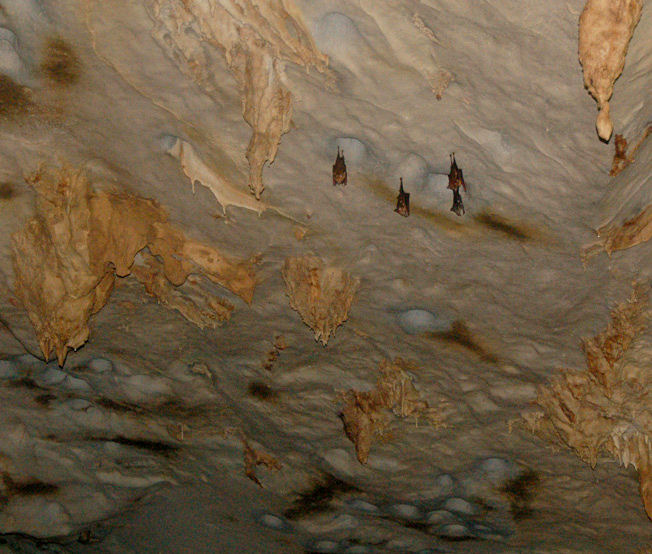
Figure 4. Bellholes in Lang’s Cave Gunung Mulu National Park, Sarawak. Photo Julia James
That text on the information board below the bellholes in Lang’s Cave is reduced and adapted here. Their formation is attributed to the power of a simple gas (carbon dioxide). If there is more carbon dioxide in the cave than the seepage waters, the gas flows from the air to the water and the water dissolves limestone from where it touches the roof. It is suggested that the visitors lookup at the roof behind them and a question is asked, see the holes. The comment follows with, a bit too much carbon dioxide in here when that happened.
Two theories have come to the forefront, both acceptable and to some extent compatible with observations, theory and experiment, and are outlined below.
First, the role of bats has been advocated as a major way in which bellholes form and become elongated vertically. Miller and Figueroa-Mulet (2009) state that in the caves of the Neotropics bellholes are only found where there are the frugivorous bats (Artibeus jamaiciensis). The bats are harem bats and roost in the bellholes. In the bellholes that are used for roosting and in the bellbasins below minerals, associated with the reaction of guano with limestone have been identified.
The coffee table book “Tsingy Stone Forest - Madagascar” (Grunwald and Wolozan, 2006) contains excellent photographs of bellholes with and without bats. The following quote presents the hypothesis for bat induced bellhole formation:
Bats appear and disappear in an elegant acrobatic ballet performance, passing from one niche to another. They never seem satisfied with what they find, though they were probably the architects of this unique décor. This geological phenomenon can be explained by the concentration of bat urine and the carbonic gases, which the bats release, in combination with humidity, which causes spot erosion. The limestone is thus weakened and detaches easily as the bats cling to it. This can be seen by closely examining the bats’ fur. When a bat wishes to descend from a niche, it plunges in the deep opening until it reaches the open space, where it merely beats its wings to prevent it falling further. The return, however, is awkward and challenging – the bat attaches to the bottom of a niche and must crawl upwards – causing more pieces to detach thus enlarging the niche. This action repeated by thousands of bat generations has pierced hundreds of niches in the roof of the Bemaraha caves, some now more than a meter deep.
Greg Middleton during his exploration of caves in Madagascar has taken many significant photographs pertaining to bellholes one, used as a bat roost is shown below (Figure 5).
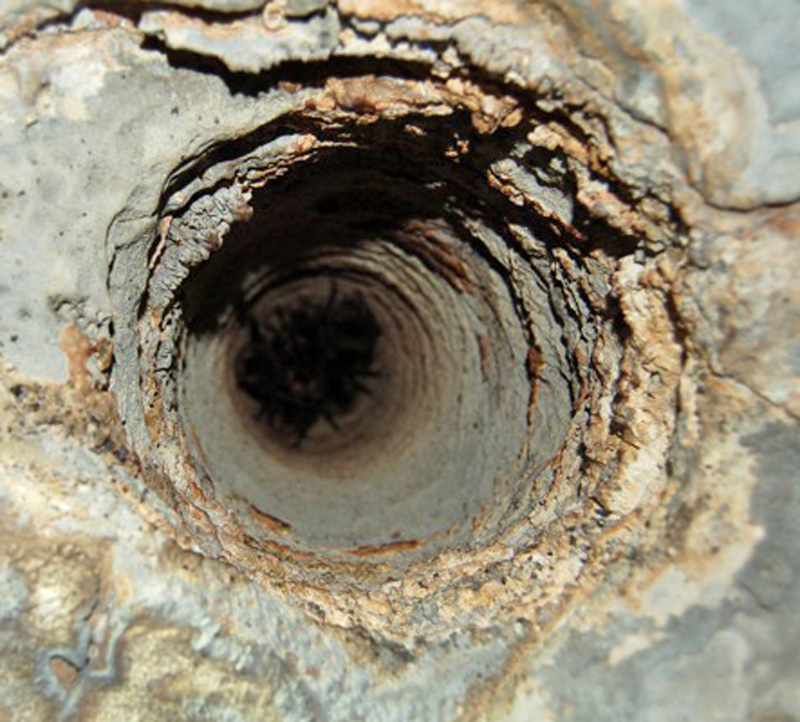
Figure 5. A harem of bats roosting in a small bellhole about 15 cm across in the roof of a 2 m high flat roofed chamber in Ambinda burial Cave, Beanka Reserve, Madagascar. Photo Greg Middleton,
The author agrees with the conclusion of Ford and Williams (2007) that bats do not form the bellholes and their presence in them is purely opportunistic. However once in situ they do have considerable potential to modify the bellhole. The bats breathe out a mixture of water vapour and carbon dioxide at a temperature higher than that of the cave wall. The mixture condenses to form a carbonic acid solution. This corrosive solution is focused at the top of the bellhole slowly eroding it upwards. Lundberg and McFarlane (2009) have calculated that a bellhole 1 m deep may be formed in 50,000 years by this mechanism alone. Bats also excrete, their urine is an ammoniacal solution of urea and is basic, it will only attack limestone if oxidized by bacteria to uric and nitrous acids. Bats faeces contain phosphates plus vegetable and insect remains. In acidic solution, phosphates will react with carbonate rocks according to the equation below.
| 9H+(aq) + PO43-(aq) + 5CaCO3(s) |  | Ca5(PO4)3(OH)(s) + 5CO2(g) + 4H2O |
In other words, the corrosion of limestone with phosphoric acid produces apatite, a mineral that is found in association with both bellholes and bellbasins. Although never stated in the literature the bellholes would provide suitable environments for a multitude of oxidizing bacteria especially those inhabited by bats. Other opportunistic inhabitants of the bellholes at Mulu are cave swiftlets, which rest in the bellholes in Lagang Cave during the middle of the day when temperature and humidity in the rainforest are greatest. Some fifty birds were observed to fly out of the bellholes in the entrance to Lagang Cave each bird leaving a separate bellhole. Although a solitary bird would not be as effective in modifying a bellhole as a harem of bats, any visitor either animal or vegetable will alter the bellhole to some degree.
If bats and birds are using the bellholes to hide from predators, they have to be large enough. Figure 4 shows where the bellholes are shallow the bats do not occupy them but are hanging from the roof adjacent to them.
While hypotheses of how bellholes become larger abound and are substantive, what are missing are suggestions as to how bellholes are initiated. It is here that one must examine the condensation corrosion mechanism initially proposed by Tarhule-Lips and Ford (1998). First, there is evidence of both condensation and condensation corrosion processes in the caves of Mulu. Condensation is a diurnal process in the tropics as is exemplified by the observation that the area of condensation droplets shown in Figure 6 actively increased around noon. In many of the Mulu caves, there is abundant evidence that both the bedrock and speleothems are weathering by condensation corrosion (Figure 7).

Figure 6. Condensation droplets in the entrance passage of Lagang Cave, Gunung Mulu National Park, Sarawak. Photo Julia James
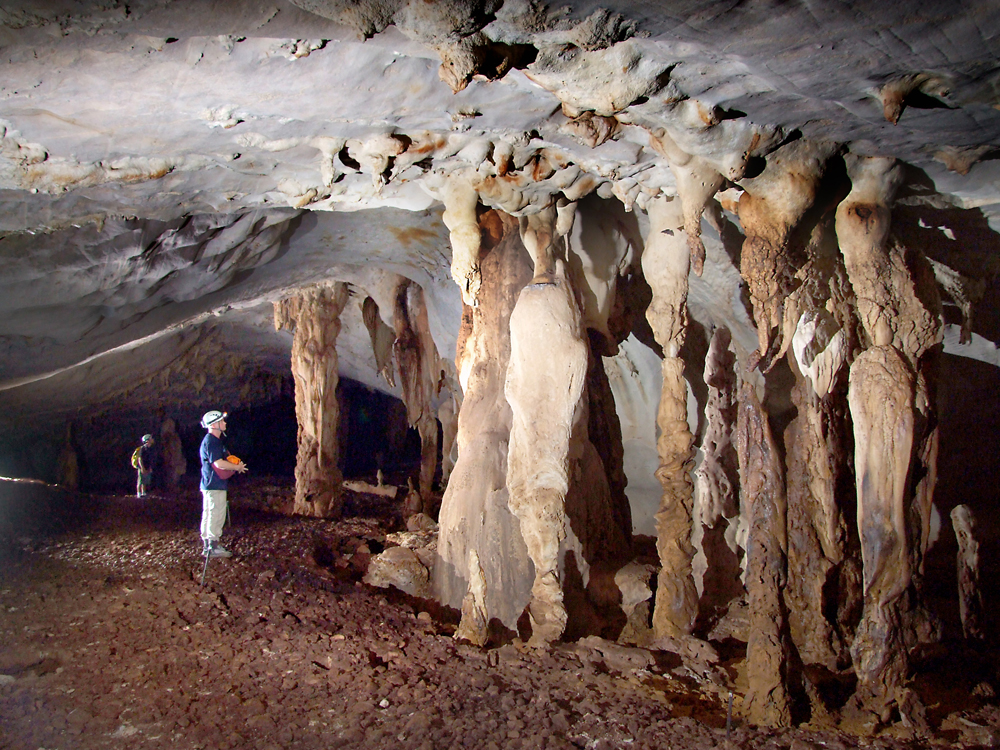
Figure 7. Speleothems degraded by condensation corrosion in Stone Horse Cave Gunung Mulu National Park, Sarawak. Photo Garry Smith.
It is now essential to re-examine Figure 3, a photograph taken in Fruit Bat Cave. From this cave, there is a connection to the lower Kenyalang Cave and because of the difference in elevation between the caves, air movement is governed by the chimney effect (Wigley and Brown, 1976). Diurnally as external temperatures and relative humidity rises, warm wet air is drawn into Fruit Bat Cave where it condenses on the colder walls.
The following observations can be made from Figure 3.
- There are condensation droplets sparkling on both the rock and tree roots.
- Tree roots are spreading across the rock invading the bellholes searching for moisture.
- The rock has a scalloped surface that is characteristic of condensation corrosion.
- In this collection of bellholes, there are embryo bellholes illustrating that the condensation corrosion is being focused into circular shapes.
- The embryo bellholes start as shallow saucers ranging in size until they can be classed as mature bellholes.
- In a number of places, mature bellholes have joined and embryo bellholes have joined to mature bellholes.
- The bellholes are clean and there are only a few dark areas around them to indicate that bats or birds may roost around the holes.
Miller and Figueroa–Mulet (2009) postulate that where there are no bats, there are no bellholes for example beyond a siphon. Beyond a siphon, there is little or no condensation corrosion because condensation requires airflow (James, 2004). Hence, the observation above does not distinguish between the two mechanisms.
Rates of condensation corrosion can be fast for instance, they have been measured in the Jenolan Show Caves at a rate of 30 mm ka-1 (James, 2004). Using this figure, a bellhole 200 mm across and 300 mm deep would form in 10,000 years. This rate of development would increase if it becomes a site for roosting bats. At Mulu, bellholes will be a rapid forming speleogen as the conditions are ideal for condensation corrosion. In Madagascar where there is a less favourable external climate, bellholes will form more slowly. Bellholes and embryo bellholes can be found in caves outside the tropics and the question must be asked are these a youthful speleogen still forming or a feature of much older processes in a cave. Figure 8 shows two features in the Jenolan Show Caves that resemble bellholes, and Lauritzen and Lundberg (2000) describe a number of features that resemble bellholes. At least for Jenolan, at present there is insufficient evidence to class these as bellholes or to determine whether they are developing speleogens or are relict.
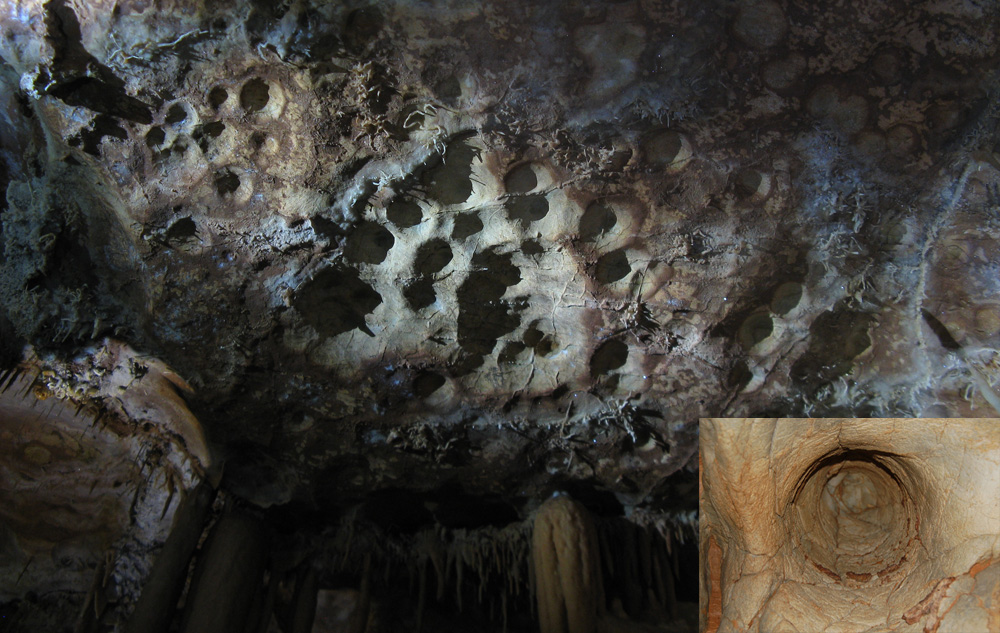
Figure 8. The roof between the Indian and Persian Chambers, Orient Cave Photo Gary Whitby. The insert is a 20 cm wide bellhole in the Diamond Cave, Photo Julia James. Both caves are part of the Jenolan Show Caves.
Conclusion
Bellholes are striking symmetrical speleogens found largely in tropical caves. The most complete hypothesis of how these features form combines the most common hypotheses, bats and condensation corrosion. Bellholes are initiated by a condensation corrosion mechanism, which can be supplemented by the impacts produced by use of these developing features by opportunistic species such as bats.
Acknowledgements
I am particularly grateful to Andy Spate who knowing my obsession with bellholes suggested I write an ‘Andy Sez’ for ACKMA. This is an introduction to the topic. Andy and I intend to prepare a more extensive review for the refereed speleological literature. I wish to thank Craig Barnes for criticism of and proof reading this paper and John Brush, Greg Middleton, Garry Smith and Gary Whitby for the use of their photographs. My special thanks to Brian Clark of Gunung Mulu National Park, Sarawak for providing guides and permission to visit bellhole sites.
References
Birmingham, A. N., J. R. Mylroie, J. E. Mylroie and M. J. Lace. (2011). Bell Hole Origins: Constraints on Development Mechanisms, Crooked Island, Bahamas. Speleogenesis and Evolution of Karst Aquifers. www.journal.speleogenesis. (10) 71-79.
Grunwald, O. and D. Wolozan. (2006). Tsingy Stone Forest – Madagascar. Altus Editions, France 191 pp.
James, J. M. (2004). Condensation corrosion. In: Gunn, J. H. (ed.), Encyclopaedia of Caves and Karst Science. Fitzroy Dearborn, UK, pp. 241-240.
Jennings, J. N. (1971). Karst. Australian National University Press, Canberra 252 pp.
Ford, D. C. and P. W. Williams. (2007). Karst Hydrogeology and Geomorphology. Wiley, Chichester, 562 pp.
Lundberg, J. and D .A. McFarlane. (2009). Bats and bell holes: The microclimatic impact of bat roosting, using a case study from Runaway Bay Caves, Jamaica. Geomorphology, 106, 78-85.
Lauritzen, S-E. and J. Lundberg. (2000). Solutional and erosional morphology. In Klimchouk, A. B., Ford, D. C., Palmer, A. N., and Dreybrodt, W., (eds.), Speleogenesis: Evolution of Karst Aquifers. National Speleological Society, Huntsville, Alabama, 408-426.
Miller, T. E. and M. Figuero-Mulet. (2009). Bellholes and bellbasins: biogenic (bat) cave features of Puerto Rico and the Neotropics. Proceedings of 15th International Congress of Speleology. Kerrville , Texas, US. 1605-1611.
Tarhule-Lips, R. F. A. and D. C. Ford. (1998). Condensation corrosion in caves of Cayman Brac and Isla de Mona. Journal of Cave and Karst Studies 25, 19-30.
White, W. B. and J. R. Dunn. (1962). Notes on the Caves of Jamaica. National Speleological Society Bulletin, 24, 9-24.
Wigley, T. M. L. and M. C. Brown. (1976) The physics of caves. In Ford, T. D. and Cullingford, C. H. D., (eds.), The Science of Speleology. London, Academic Press, pp 329-358.
Wilford, C. E. (1966). “Bell Holes” in Sarawak Caves. Bulletin of the National Speleological Society 28, 179-182.